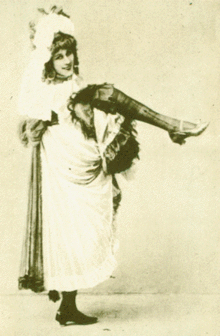Jane Avril


Jane Avril (1868–1943) was a French can-can dancer made famous by Henri de Toulouse-Lautrec through his paintings. Extremely thin, 'given to jerky movements and sudden contortions', she was nicknamed La Mélinite, after an explosive.[1]
Biography
She was born Jeanne Beaudon in Belleville, on June 9, 1868 (Though her biographer, Shercliff - whose account of the dancer's life is highly romanticised - used the surname Richepin in her publication). Her mother was a courtesan and her absent father, allegedly, was a foreign aristocrat. Abused as a child, she ran away from home, and was eventually admitted to the Salpêtrière Hospital, with the movement disorder 'St Vitus' Dance' (now thought to be Sydenham's Chorea). Under the care of Dr. Jean-Martin Charcot, the expert on "female hysterics" she received various kinds of treatment, and claimed in her biography that, when she discovered dance at a social dance for employees and patients at the hospital, she was cured. On leaving the hospital, after a failed romance, Jeanne thought to kill herself, but was taken in by the Madame of a Parisian brothel.

Working at whatever day jobs were available, at night she pursued a career in dancing by performing at local clubs. In 1888, she met the writer René Boylesve (1867–1926) who is said to have become quite taken by the beautiful but shy young girl. Using the stage name Jane Avril, she built a reputation that eventually allowed her to make a living as a full-time dancer. Hired by the Moulin Rouge nightclub in 1889, within a few years she headlined at the Jardin de Paris, one of the major café-concerts on the Champs-Élysées. To advertise the extravaganza, Henri de Toulouse-Lautrec painted her portrait on a poster that elevated her stature in the entertainment world even further. The popularity of the Cancan became such that Jane Avril travelled with a dance troupe to perform in London.
In 1895, the owners of the Moulin Rouge offered her a great deal of money to take on the risky task of replacing Louise Weber, the most famous dancer in Paris, known by her stage name as "La Goulue". Graceful, soft-spoken, and melancholic, Jane Avril gave a dance presentation that was the opposite of the very boisterous La Goulue. Nevertheless, the club's patrons adored her and she became one of the most recognizable names of the Parisian nightlife. That same year, Avril gave birth to a son but quickly returned to dancing and remained a star for many more years.
A woman of intelligence and with a sense of aloof grace, at age 42 she met and married the German artist, Maurice Biais (c.1875–1926), and the couple moved to a home in Jouy-en-Josas at the outskirts of Paris. However, her husband soon began to stray, often disappearing for days at a time, and for years she lived a miserable existence with the irresponsible Biais. Without any financial support following his death in 1926, Avril lived in near poverty on what little was left of her savings.
Jane Avril died in a seniors' home in 1943 at the age of 75. She was interred in the Père Lachaise Cemetery in Paris.[2]
Zsa Zsa Gabor portrayed Avril in the original Moulin Rouge (1952); half a century later, the semi-fictionalized character was reinterpreted by Nicole Kidman in Moulin Rouge! (2001). Avril is one of the characters in Per Olov Enquist's book The Book of Blanche and Marie, which portrays the lives of Blanche Wittman and Marie Curie.
References
- ↑ Dancer to the music of time, Adrian Hamilton, The Independent, 20 June 2011
- ↑ "Jane Avril". Find-A-Grave. Retrieved 8 June 2011.
Bibliography
- Shercliff, Jose (1952). Jane Avril of the Moulin Rouge. London: Jarrolds Publishers, Ltd. OCLC 1477795.
Jane Avril, Mes memoires, Paris, 2005 Nancy Ireson, Toulouse-Lautrec and Jane Avril: Beyond the Moulin Rouge, London, 2011
Further reading
- Caradec, François (2001). Jane Avril : au Moulin Rouge avec Toulouse-Lautrec (in French). Paris: Fayard. ISBN 2-213-60888-1.
External links
| Wikimedia Commons has media related to Jane Avril. |
- Jane Avril of the Moulin Rouge - Dedicated Website
- Toulouse-Lautrec and Jane Avril beyond the Moulin Rouge - Courtauld Gallery, London
- Toulouse-Lautrec in the Metropolitan Museum of Art, a full text exhibition catalog from The Metropolitan Museum of Art, which contains material on Jane Avril
| ||||||||
|